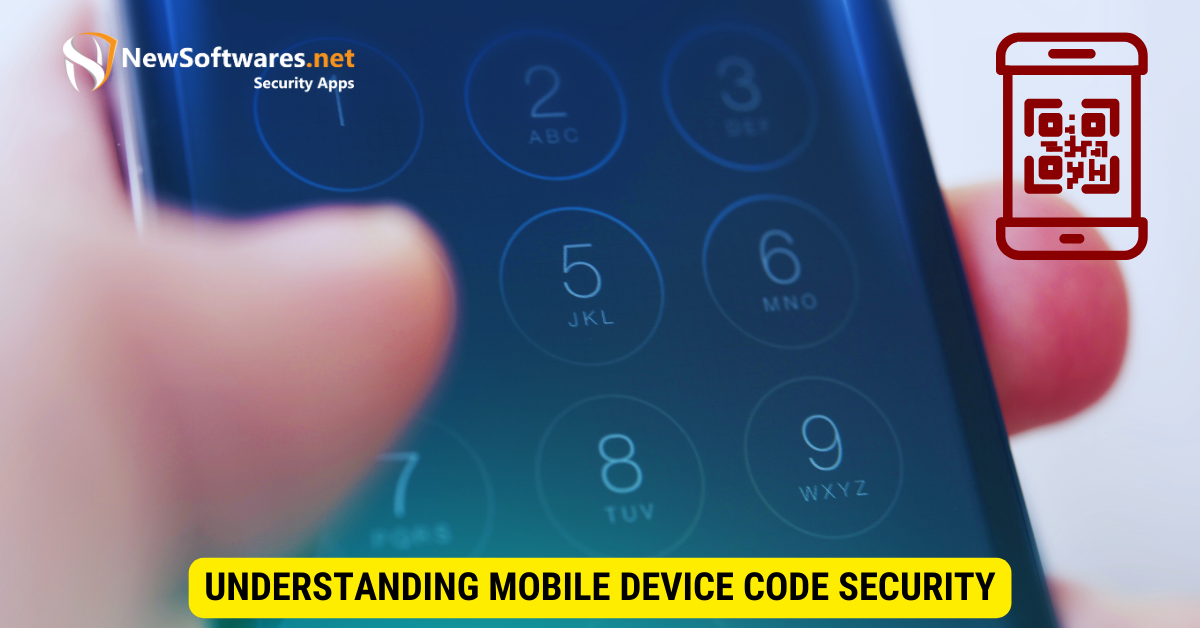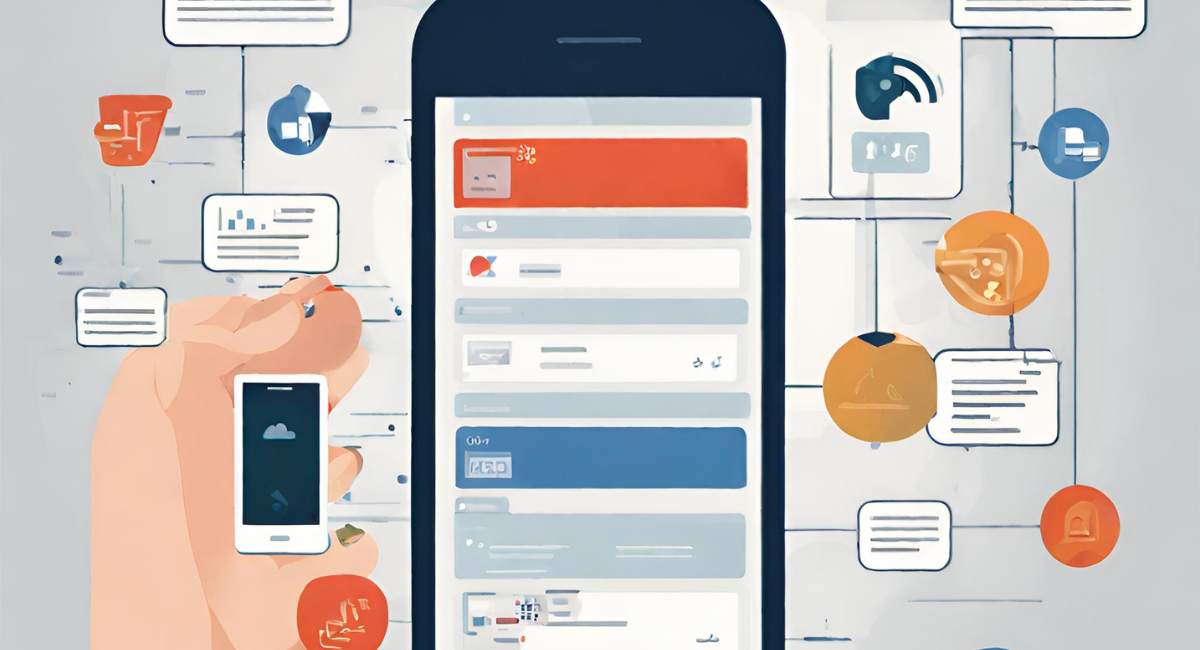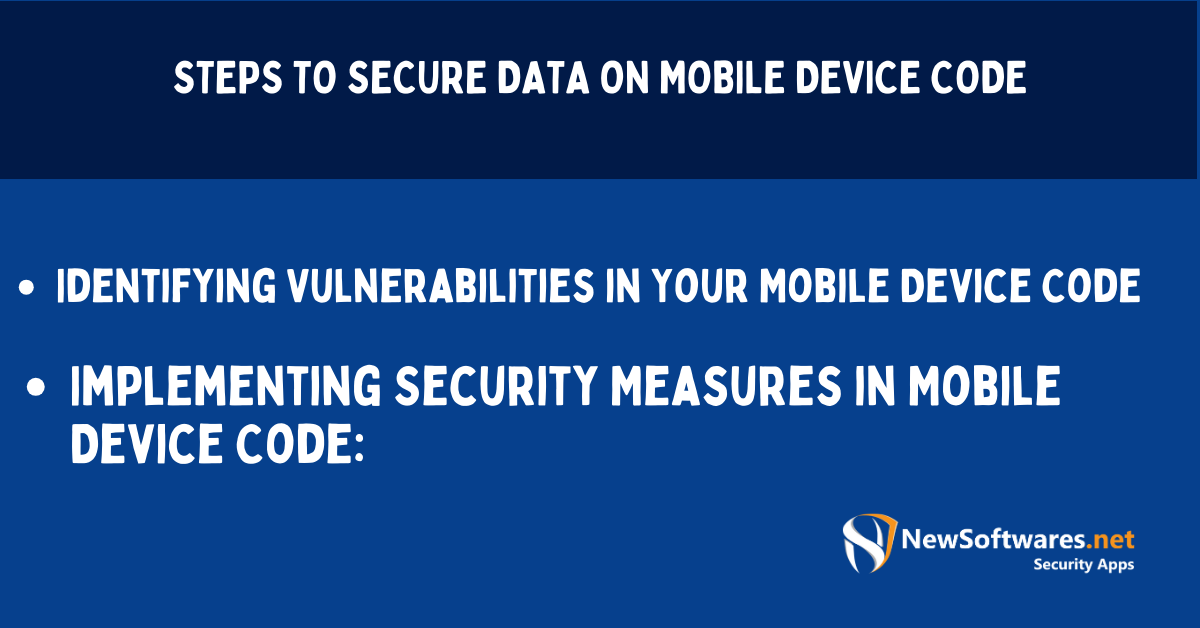To secure data on mobile device code, use encryption, maintain app updates, limit permissions, implement proper authentication mechanisms, and regularly review and monitor security vulnerabilities.
Mobile devices have become an essential part of our daily lives. These devices have revolutionized how we communicate, work, and access information from smartphones to tablets. However, with the increasing reliance on mobile devices, securing data on mobile device codes has become more critical. We will learn the position of mobile device code security, key concepts in mobile device code security, steps to secure data on mobile device code, advanced techniques for mobile device code security, maintaining security in mobile device code, and the future of mobile device code security.
Understanding Mobile Device Code Security

The Importance of Mobile Device Code Security

As mobile devices continue to change and become more sophisticated, the amount of data stored on these devices has also increased exponentially. Mobile devices now hold a wealth of valuable information, from personal information such as contacts and messages to sensitive financial data and corporate information. This makes them an attractive target for cybercriminals constantly devising new ways to exploit vulnerabilities.
Robust mobile device code security has become paramount with the rise of mobile banking, e-commerce, and social media applications. Without proper security measures in place, users are at risk of having their personal and financial information compromised. This can lead to identity stealing, financial loss, and reputational damage.
Key Concepts in Mobile Device Code Security
Mobile device code security encompasses various concepts and practices to protect the integrity, confidentiality, and availability of data stored on mobile devices. It involves executing measures to prevent unauthorized access, detecting and mitigating vulnerabilities, and ensuring user data privacy.
One of the key concepts in mobile device code security is encryption. Encoding is the process of encoding data so that only authorized parties can admit it. By encoding sensitive data stored on mobile devices, even if the device falls into the wrong hands, the data remains inaccessible without the encryption key.
Another important concept is secure coding practices. Mobile app developers must follow secure coding guidelines to minimize the risk of introducing vulnerabilities into their applications. This includes practices such as input validation, proper error handling, and secure storage of sensitive data.
Mobile device code security also involves implementing strong authentication mechanisms. This safeguards that only authorized users can access the device and its data. Strong authentication mechanisms include biometric authentication (such as fingerprint or facial acknowledgment) and two-factor authentication (requiring both a password and a verification code).
Regular security updates and patches are crucial in mobile device code security. Mobile device manufacturers and software developers release updates to discourse known vulnerabilities and improve the device’s overall security. It is important for users to regularly update their devices to ensure they are protected against the latest threats.
In addition to these concepts, mobile device code security includes practices such as app sandboxing, isolating apps from each other and the underlying operating system, and secure network communication, ensuring that data transmitted between the device and external servers is encrypted and protected from interception.
Overall, mobile device code security is a multi-faceted approach that requires a combination of technical measures, user awareness, and regular updates. By implementing robust security practices, users can protect their valued data and minimize the risk of falling victim to cyberattacks.
Steps to Secure Data on Mobile Device Code

Securing data on mobile devices is of utmost importance in today’s digital age. With the growing reliance on smartphones and tablets for various tasks, ensuring that sensitive info remains protected from unauthorized access is crucial. let’s realize the steps in securing data on mobile device code.
Identifying Vulnerabilities in Your Mobile Device Code
One of the first steps in securing mobile device code data is identifying potential vulnerabilities. This can be done through regular security reviews and vulnerability assessments. By analyzing the code and conducting penetration testing, developers can uncover any weaknesses or loopholes attackers could exploit.
Developers meticulously review the codebase during a security audit to identify potential vulnerabilities. They examine the code for common security flaws such as buffer overflows, injection attacks, and insecure data storage practices. By conducting vulnerability assessments, developers can gain insight into the overall security posture of the mobile application and identify areas that require immediate attention.
Implementing Security Measures in Mobile Device Code
Once vulnerabilities have been identified, it is crucial to implement appropriate security measures. This may include using secure coding practices, such as input validation and secure storage of sensitive data. Designers should follow best practices for secure coding, ensuring user input is properly validated to prevent common attacks like cross-site scripting (XSS) and SQL injection.
Secure storage of sensitive data is another critical aspect of securing mobile device code. Developers should utilize encryption algorithms to protect data at rest and in transit. By encrypting sensitive information, even if attackers gain unauthorized access to the device or intercept the data during transmission, they cannot decipher the encrypted content.
Additionally, developers should adhere to industry-standard encryption protocols and authentication mechanisms to protect data. Strong authentication mechanisms, such as two-factor or biometric authentication, add an extra layer of security to the mobile application.
Advanced Techniques for Mobile Device Code Security
Encryption and Mobile Device Code Security
Encryption plays a vital role in mobile device code security. By encrypting data at rest and in transit, developers can ensure that the data remains unintelligible even if a device falls into the wrong hands. Implementing strong encryption algorithms and key management practices is essential in safeguarding sensitive information.
When it comes to encryption, various techniques can be employed. One commonly used method is symmetric encoding, where the same key is used for encryption and decryption. This approach delivers a fast and efficient way to secure data. Another technique is asymmetric encryption, which involves using a public key to encode the data and a private key to decrypt it. This method offers a higher level of security as the private key is kept secret.
In addition to encryption, mobile device code security involves secure key management practices. This includes generating strong and unique encryption keys, securely storing and transmitting them, and regularly updating them to prevent unauthorized access. Key management is crucial in ensuring the integrity and confidentiality of the encrypted data.
Using Authentication in Mobile Device Code
Authentication is another critical component of mobile device code security. Developers can ensure that only authorized individuals can access sensitive data by employing strong authentication mechanisms, such as biometrics or two-factor authentication. This helps defend against unauthorized access and data breaches.
Biometric authentication has recently increased in popularity due to its convenience and enhanced security. It involves using unique physical or behavioral features, such as fingerprints, facial recognition, or voice credit, to verify a user’s identity. This method provides a high level of confidence in the authenticity of the user.
On the other hand, two-factor authentication enhances an extra coating of security by demanding users offer two different types of credentials to access their mobile devices or applications. This typically involves something the worker knows, such as a password, and something the operator possesses, such as an itinerant device or a security token. Combining these two factors significantly reduces the risk of unauthorized access.
Furthermore, developers can implement additional security measures, such as device attestation and secure boot, to enhance mobile device code security. Device attestation verifies the integrity and authenticity of a device, ensuring that it has not been tampered with or compromised. On the other hand, secure boot ensures that only trusted and authorized software is loaded during the device startup process, protecting against malicious code injection.
In conclusion, encryption and authentication are essential techniques for mobile device code security. By implementing strong encryption algorithms, secure key management practices, and robust authentication mechanisms, developers can enhance the security of mobile devices and protect sensitive data from unauthorized access and breaches.
Maintaining Security in Mobile Device Code
Regular Updates and Patches
Maintaining security in mobile device code requires continuous monitoring and regular updates. Developers should stay up-to-date with the latest security patches and release timely updates to address any newly discovered vulnerabilities. Promptly addressing security issues is crucial in minimizing the risk of data breaches.
Monitoring and Responding to Security Threats
Mobile device code security is not a one-time effort but an ongoing process. Establishing processes for monitoring security threats, analyzing attack patterns, and responding promptly to detected breaches is essential. Implementing intrusion detection and prevention systems can help quickly detect and mitigate security threats.
Future of Mobile Device Code Security
Emerging Trends in Mobile Device Code Security
Mobile device code security is constantly evolving, and new trends and technologies are emerging to address the ever-growing threats. From artificial intelligence-powered security solutions to blockchain-based data integrity, companies are embracing innovative approaches to protect data on mobile devices.
Preparing for Future Security Challenges in Mobile Device Code
To address future security challenges, organizations must adopt a proactive approach. This involves investing in research and development, partnering with cybersecurity experts, and fostering a culture of security awareness. Organizations can better prepare for the evolving threat landscape by staying ahead of the curve.
Key Takeaways
- Always encrypt sensitive data stored on mobile devices.
- Update apps regularly to address potential vulnerabilities.
- Limit app permissions to only what’s necessary.
- Utilize strong authentication methods like biometrics or multi-factor authentication.
- Monitor and address security threats continuously.
FAQs
Q: What is the importance of encrypting data on mobile devices?
A: Encryption ensures that even if data is accessed, it remains unreadable without the right decryption key.
Q: Why should I regularly update apps?
A: Regular updates often contain security patches for known vulnerabilities.
Q: Are biometrics, like fingerprint scanning, safe for mobile security?
A: While no method is foolproof, biometrics offer a higher security level than simple passwords.
Q: How can I monitor security threats on mobile devices?
A: Invest in security software or services designed for mobile threat detection.
Q: Should I be wary of granting permissions to apps?
A: Yes, always ensure apps only have permissions necessary for their function to minimize exposure.
Conclusion
Securing data on mobile device code is an ongoing process that requires constant vigilance and adherence to best practices. By classifying vulnerabilities and implementing appropriate security measures, developers can significantly reduce the risk of data breaches and unauthorized access. Developers need to stay updated with the latest security trends and regularly update their mobile applications to address any new vulnerabilities that may arise.
